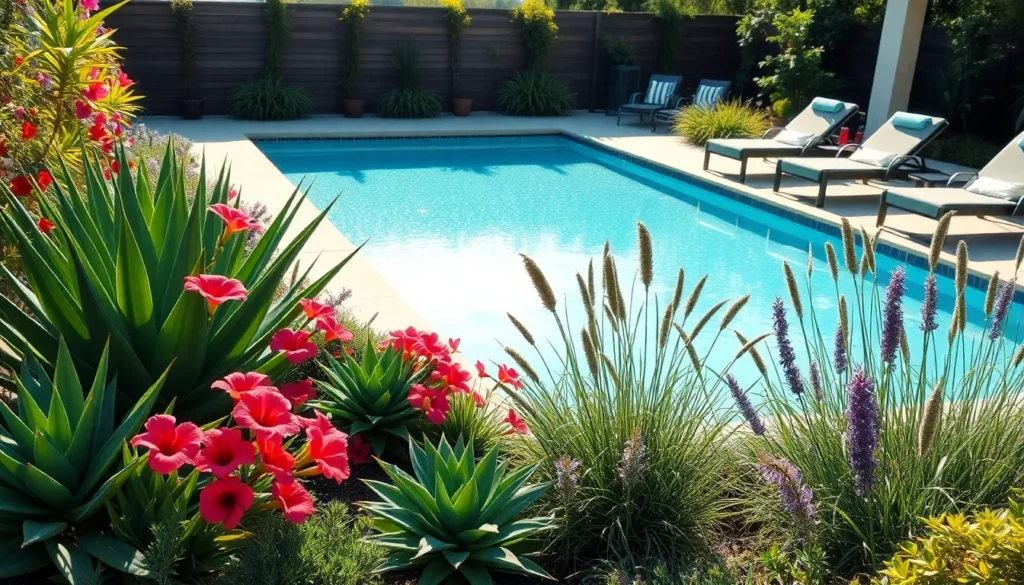Creating a stunning poolside oasis goes beyond just the pool itself – the right plants can transform your backyard into a tropical paradise that rivals any luxury resort. We’ve all seen those magazine-perfect pool areas where lush greenery frames crystal-clear water but choosing the wrong plants can quickly turn your dream space into a maintenance nightmare.
Salt spray chlorine splash and intense sun exposure make poolside gardening uniquely challenging. Not every plant can handle these harsh conditions while still looking gorgeous year-round. That’s why we’ve spent countless hours researching and testing to find the perfect plant combinations that thrive in pool environments.
The secret lies in selecting species that love heat tolerate chemicals and won’t drop leaves or flowers into your pristine water. With our carefully curated list you’ll discover low-maintenance options that create privacy add fragrance and provide that coveted resort-style ambiance you’ve been craving.
Best Low-Maintenance Plants for Around the Pool
Now that we’ve established the importance of selecting chemical-resistant and heat-tolerant species, let’s explore the top low-maintenance options that’ll transform your pool area into a stunning retreat.
Drought-Tolerant Succulents
Agave plants create dramatic focal points around pools with their architectural rosette shapes and sharp-edged leaves. These desert natives require watering only once every two weeks during growing season and can withstand chlorine splash without damage. Blue agave and century plant varieties work exceptionally well in modern pool designs.
Aloe vera specimens offer both beauty and functionality near swimming areas. Their thick, fleshy leaves store water for months, making them perfect for busy homeowners who travel frequently. We recommend placing them in decorative containers along pool edges where their soothing gel provides natural sunburn relief for swimmers.
Echeveria collections bring color variety to poolside gardens through their rosette formations in shades of blue, purple, and silver. These compact succulents multiply naturally, creating fuller displays each season without additional planting costs. Hens and chicks varieties spread quickly to fill large areas with minimal water requirements.
Hardy Perennial Grasses
Fountain grass creates graceful movement around pool perimeters with its arching blades and feathery plumes. This ornamental grass tolerates salt spray from pool activities and grows 3-4 feet tall, providing natural privacy screening. Purple fountain grass adds burgundy tones that complement pool tile colors beautifully.
Pampas grass establishes dramatic backdrops for swimming areas with its towering 6-8 foot height and silvery plumes. Once established, this perennial requires cutting back only once yearly and survives drought conditions that would kill traditional lawn grass. Dwarf varieties work better for smaller pool spaces.
Zebra grass develops distinctive horizontal stripes that add visual interest throughout the swimming season. Its clumping growth habit prevents invasive spreading while creating natural borders between pool decking and industry beds. This ornamental grass turns golden bronze in fall, extending seasonal appeal.
Evergreen Shrubs
Boxwood hedges provide year-round structure around pool areas with their dense, compact foliage that maintains shape with minimal pruning. These versatile shrubs tolerate chlorine exposure and create formal borders that complement any pool design style. Dwarf English boxwood varieties stay under 3 feet for easy maintenance.
Rosemary bushes combine aromatic herbs with attractive evergreen foliage that releases pleasant scents when brushed against by swimmers. This Mediterranean native thrives in hot, sunny pool environments and requires pruning only twice yearly to maintain shape. Upright varieties like Tuscan Blue work well as privacy screens.
Juniper specimens offer diverse textures and colors for poolside landscaping through varieties like Blue Star, Gold Coast, and Spartan juniper. These drought-resistant evergreens withstand harsh pool chemicals while providing year-round coverage that never goes dormant. Creeping varieties work excellently as ground cover between pavers.
Tropical Plants That Thrive in Pool Areas
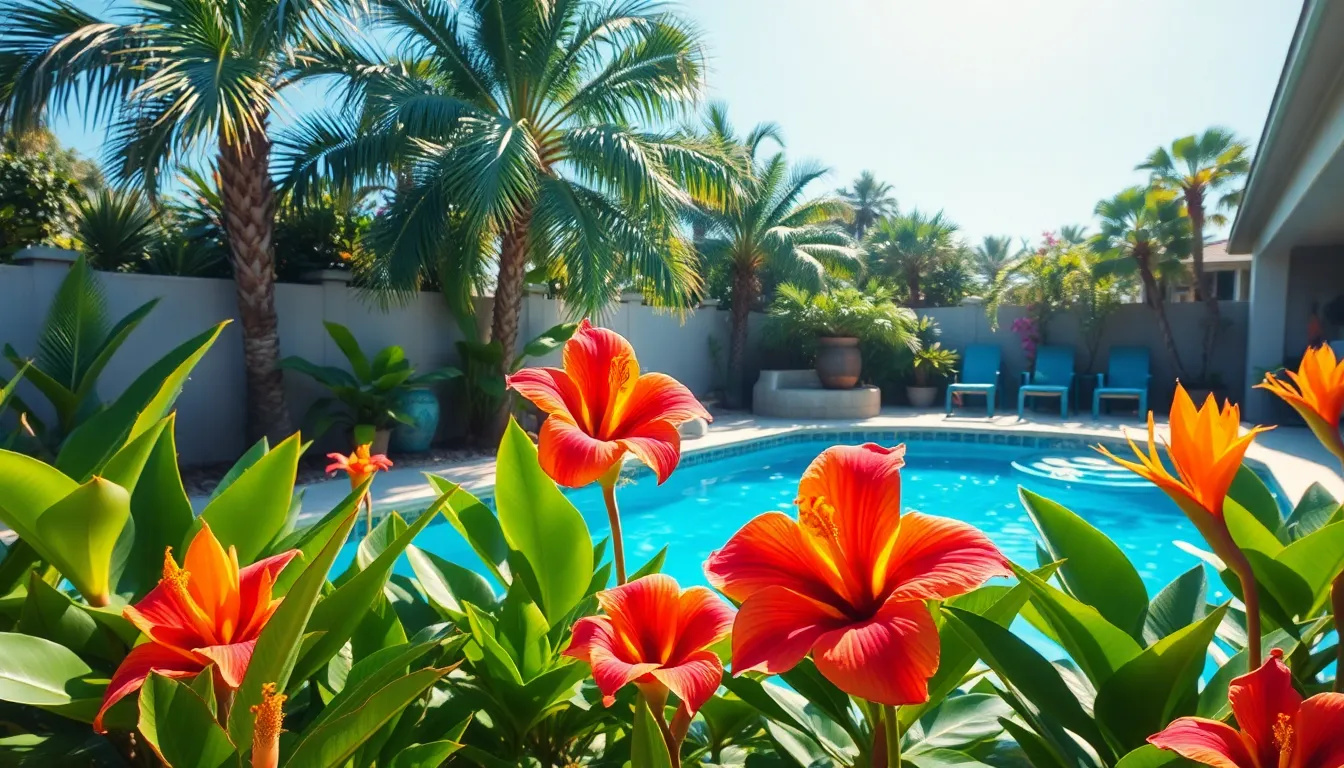
Building on our low maintenance foundation, we can elevate our poolside paradise with tropical plants that transform any backyard into a luxurious resort escape. These exotic beauties thrive in USDA hardiness zones 9-11 and create the perfect balance of bold foliage and vibrant blooms.
Palm Varieties for Poolside Landscaping
Creating natural privacy screens becomes effortless with the right palm selections. These classic tropical specimens provide essential shade while establishing that coveted beach resort atmosphere around our pools. Various palm species excel in full sun conditions and handle periodic dry spells without compromising their dramatic appeal.
Maintenance concerns disappear when we choose palms that minimize debris drop. Smart selections reduce our pool cleaning time while maximizing the layered greenery effect that makes tropical landscaping so captivating. We recommend focusing on varieties that offer height variation and wind resistance to protect our investment.
Strategic placement of palms creates natural windbreaks that benefit our entire poolside network. These towering beauties shield more delicate plants from harsh conditions while establishing the structural backbone of our tropical design.
Colorful Flowering Hibiscus
Hawaiian hibiscus (Hibiscus rosa-sinensis) delivers the most spectacular poolside color show we can achieve. Large blooms in brilliant reds, pinks, yellows, and oranges create stunning focal points that brighten our entire outdoor space. This flowering powerhouse thrives in rich, well-drained soil with partial to full sun exposure.
Consistent blooming throughout the growing season keeps our pool area vibrant and inviting. We can count on hibiscus to provide reliable color that complements our tropical theme while requiring minimal intervention. These plants adapt well to container growing, giving us flexibility in our design layout.
Zones 9-11 provide the ideal climate for hibiscus to reach its full potential. In cooler regions, we can grow these beauties in containers and bring them indoors during winter months to protect our investment.
Exotic Bird of Paradise
Bird of Paradise (Strelitzia reginae) stands out as the ultimate statement plant for sophisticated pool landscapes. Its dramatic flowers mimic birds in flight with striking white, orange, and blue combinations that create unmatched visual impact. These architectural plants reach 3.5 to 6 feet tall with banana-like leaves that add broad texture and natural shade.
Practical benefits make Bird of Paradise as functional as it is beautiful. The plant tolerates occasional pool splashing and moderate drought conditions, proving that exotic doesn’t mean high maintenance. We appreciate how these plants handle the unique challenges of poolside environments.
Optimal growing conditions include partial sun and rich soil with wind protection. Strong winds can tear the large leaves, so we position these plants in sheltered areas where their dramatic foliage stays intact. Hardy in zone 11, we can overwinter these tropical treasures indoors in cooler climates to enjoy them year after year.
Salt-Resistant Plants for Chlorinated Pool Environments
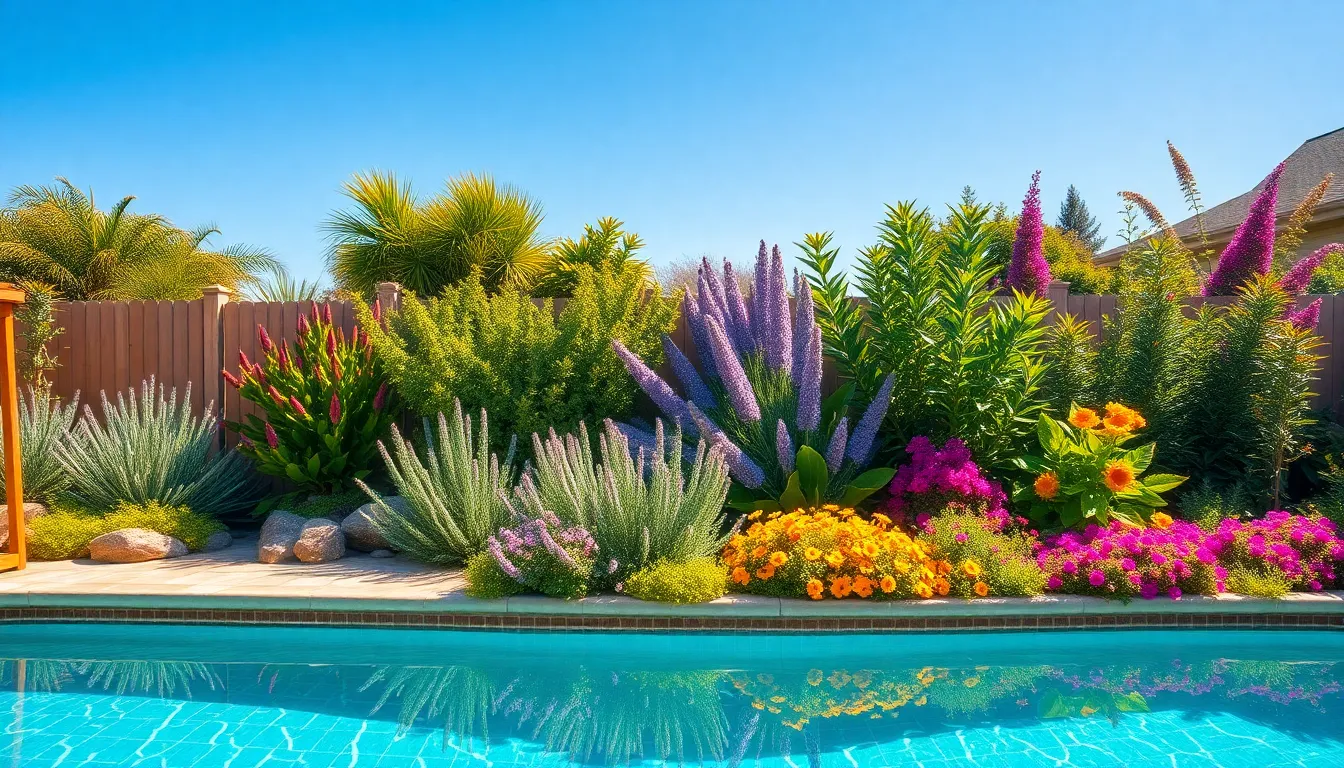
Chlorinated pool water creates unique challenges for nearby plants due to salt accumulation and chemical exposure. We’ve identified plants that thrive even though these harsh conditions while maintaining their beauty and functionality.
Mediterranean Herbs and Lavender
Mediterranean herbs offer exceptional salt tolerance while delivering aromatic benefits to your poolside sanctuary. Rosemary stands out as an evergreen powerhouse that withstands salt spray while providing year-round foliage and fragrant essential oils. Lavender varieties create stunning purple blooms and release calming scents that enhance relaxation during pool sessions.
These drought-adapted plants require minimal irrigation once established, making them perfect for hot poolside microclimates. Rosemary’s woody stems provide structural interest even during dormant seasons. Lavender’s silvery foliage adds textural contrast against darker pool surfaces and hardscaping materials.
We recommend planting these herbs in well-draining soil at least 3 feet from pool edges to minimize direct splash exposure. Their natural tolerance to sandy, alkaline conditions mirrors typical pool environment soil compositions.
Coastal Native Plants
Coastal native species evolved specifically to handle salt spray and sandy soils, making them ideal poolside companions. Sea lavender produces delicate purple flower clusters that create soft visual transitions between hardscaping and planted areas. Spanish bayonet yucca adds architectural drama with sword-like leaves and towering white flower spikes.
Beach sunflower provides cheerful yellow blooms throughout growing seasons while tolerating constant salt exposure. Gaillardia offers vibrant red and yellow daisy-like flowers that attract beneficial pollinators to your pool industry. Seaside goldenrod delivers late-season color when most other plants begin dormancy.
Ornamental grasses like pink muhly grass create stunning fall displays with cotton candy-colored plumes. Saltmeadow cordgrass provides natural movement and sound as breezes rustle through its fine blades. These native options require virtually no supplemental watering once established in coastal regions.
Salt-Tolerant Ground Covers
Ground covers prevent soil erosion around pool areas while creating cohesive visual flow between different industry zones. Railroad vine spreads naturally across sandy soils and produces morning glory-like purple flowers during warm months. Gopher apple forms dense mats that suppress weeds while offering small white blooms and edible fruits.
Lantana varieties deliver continuous color through multiple flower clusters in shades of yellow, orange, red, and white. Bee balm creates fragrant carpets that attract hummingbirds and butterflies while tolerating salt accumulation in soil. These spreading plants fill gaps between larger specimens without requiring frequent replacement.
We suggest installing these ground covers in areas where foot traffic is minimal to prevent damage. Their low growth habits complement taller poolside plants while reducing maintenance requirements compared to traditional lawn grass alternatives.
Non-Invasive Plants That Won’t Damage Pool Equipment
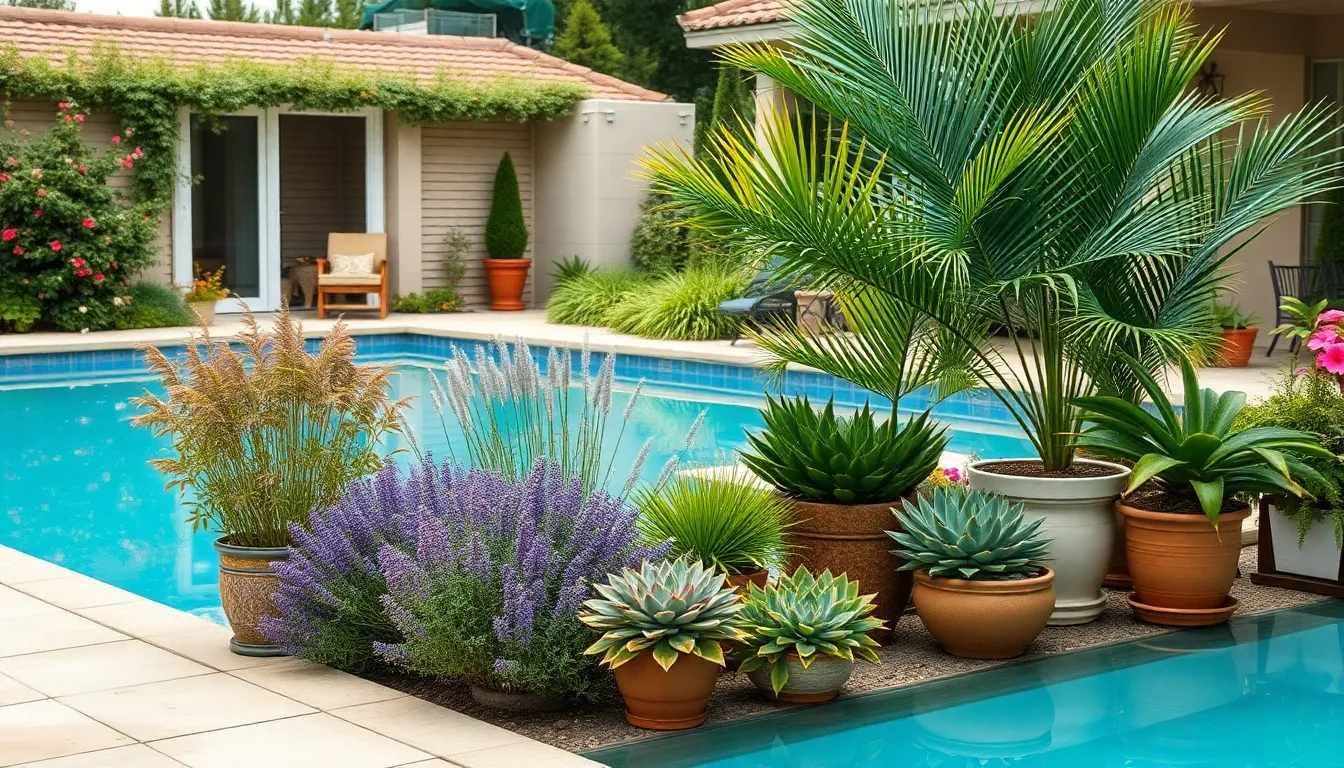
When selecting poolside plants, we must prioritize species with controlled root systems that won’t threaten pool infrastructure or equipment. Avoiding invasive root damage protects your investment while maintaining the beauty you’ve carefully cultivated.
Shallow-Rooted Ornamental Plants
Coral bells offer stunning foliage without the worry of root damage to underground systems. These versatile perennials showcase striking colors from purple to silver, adapting well to partial shade conditions around pool areas. We’ve found them particularly effective because their shallow root systems stay well above pool plumbing lines.
Lavender creates aromatic borders while maintaining safe root boundaries around pool equipment. This Mediterranean favorite thrives in well-drained soil and adds both fragrance and visual appeal to your poolside retreat. Tall sedums complement lavender beautifully, providing seasonal interest with their succulent foliage and late summer blooms.
Ornamental grasses deliver texture and movement without invasive growth patterns. Varieties like fountain grass and feather reed grass establish quickly while keeping their roots contained, making them ideal for areas near pool decking. These grasses also resist pool chemicals better than many traditional industry plants.
Compact Flowering Bushes
Rose bushes provide natural privacy screens while maintaining controlled growth habits. Shrub roses, wild varieties, and rugosa types tolerate intense poolside sun exposure while offering fragrant blooms throughout the growing season. Their thorny branches create effective security barriers without spreading beyond designated planting areas.
Holly bushes deliver year-round structure with non-invasive root systems that respect pool boundaries. Varieties like Blue Princess and Nellie Stevens maintain compact forms while providing evergreen privacy screening. We recommend these because their spiny leaves naturally deter unwanted foot traffic around sensitive pool equipment areas.
Barberry shrubs combine colorful foliage with natural security features in manageable sizes. These hardy bushes produce vibrant red or yellow fall colors while their thorny branches discourage trespassing near pool systems. Firethorn shrubs offer similar benefits with the added appeal of bright orange berries for seasonal interest.
Container-Friendly Pool Plants
Succulent gardens in decorative containers eliminate root spread concerns entirely. Varieties like agave, echeveria, and jade plants thrive in poolside conditions while remaining completely contained within their planters. We can move these arrangements seasonally or replace them easily without disrupting pool infrastructure.
Tropical palms in large planters create instant ambiance without underground root interference. Container-grown palms like parlor palm or lady palm adapt well to poolside conditions while allowing complete control over their placement and growth. These plants add height and tropical appeal without any risk to buried pool lines or equipment.
Ornamental grasses flourish in containers while providing flexible design options around pool areas. Potted grasses like purple fountain grass or zebra grass can be repositioned as needed for parties or maintenance access. Container planting also allows us to control watering and prevent excess debris from falling into pool water.
Slip-Resistant Ground Cover Options for Pool Decks
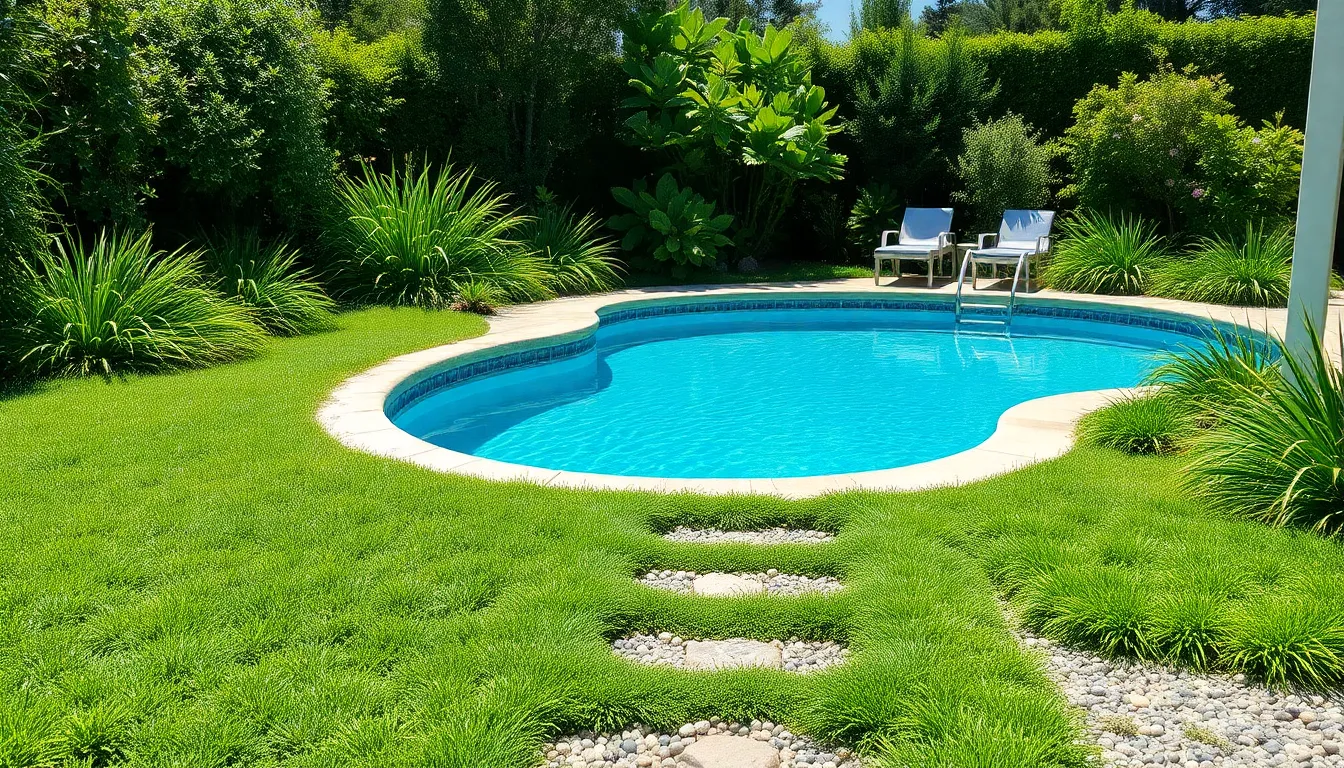
Safety around pool areas requires careful consideration of surface materials that maintain traction even when wet. We’ll explore natural ground cover alternatives that combine beauty with practical slip resistance for your poolside industry.
Soft Moss Alternatives
Natural moss creates slippery hazards when wet, making it unsuitable for pool areas even though its attractive appearance. We recommend low growing ground covers that mimic moss’s lush texture while providing superior traction in moist environments.
Creeping thyme varieties offer the soft carpet effect you’re seeking without compromising safety. These aromatic plants tolerate foot traffic exceptionally well and dry quickly after exposure to pool splashes. Sedum species create dense, succulent mats that feel cushioned underfoot while maintaining excellent grip properties. Both options deliver the visual softness of moss with dramatically improved poolside safety performance.
Low Growing Creeping Plants
Strategic plant selection transforms pool edges into safe, beautiful transitions between hardscape and industry areas. We’ve identified several creeping varieties that excel in poolside conditions while reducing slip hazards.
Creeping Thyme (Thymus serpyllum) forms fragrant, low maintenance carpets that handle moderate foot traffic without becoming slippery. This hardy perennial dries rapidly and provides a slightly textured surface that enhances traction around pool perimeters.
Irish Moss (Sagina subulata) creates fine textured ground cover with dense mat formation that stays relatively slip resistant. We particularly appreciate its moss like appearance that satisfies aesthetic goals while delivering practical safety benefits.
Blue Star Creeper (Isotoma fluviatilis) develops dense, low growing carpets punctuated by small star shaped flowers throughout the growing season. This versatile ground cover excels at filling gaps between pavers while offering natural grip enhancement.
All these selections require well drained soil and moderate watering schedules to prevent slippery conditions from excess moisture accumulation.
Textured Pathway Plants
Pathway safety around pools benefits from plants that naturally create textured surfaces to reduce slip incidents. We recommend combining tough, fibrous plants with strategic placement of small pebbles or mulch to enhance natural traction properties.
Dwarf mondo grass (Ophiopogon japonicus) forms dense tufts that provide reliable traction while creating defined pathway edges. These compact grass clumps maintain their structure season after season with minimal maintenance requirements.
Corsican Mint (Mentha requienii) grows extremely low with naturally textured surfaces that release pleasant fragrance when stepped on. This aromatic ground cover tolerates light foot traffic while contributing to poolside ambiance.
Plant friendly porous materials like decomposed granite or pea gravel work excellently as pathway fillers between plantings. These materials enhance both safety performance and visual appeal while supporting proper drainage around your pool industry.
Fragrant Plants to Enhance Your Pool Experience
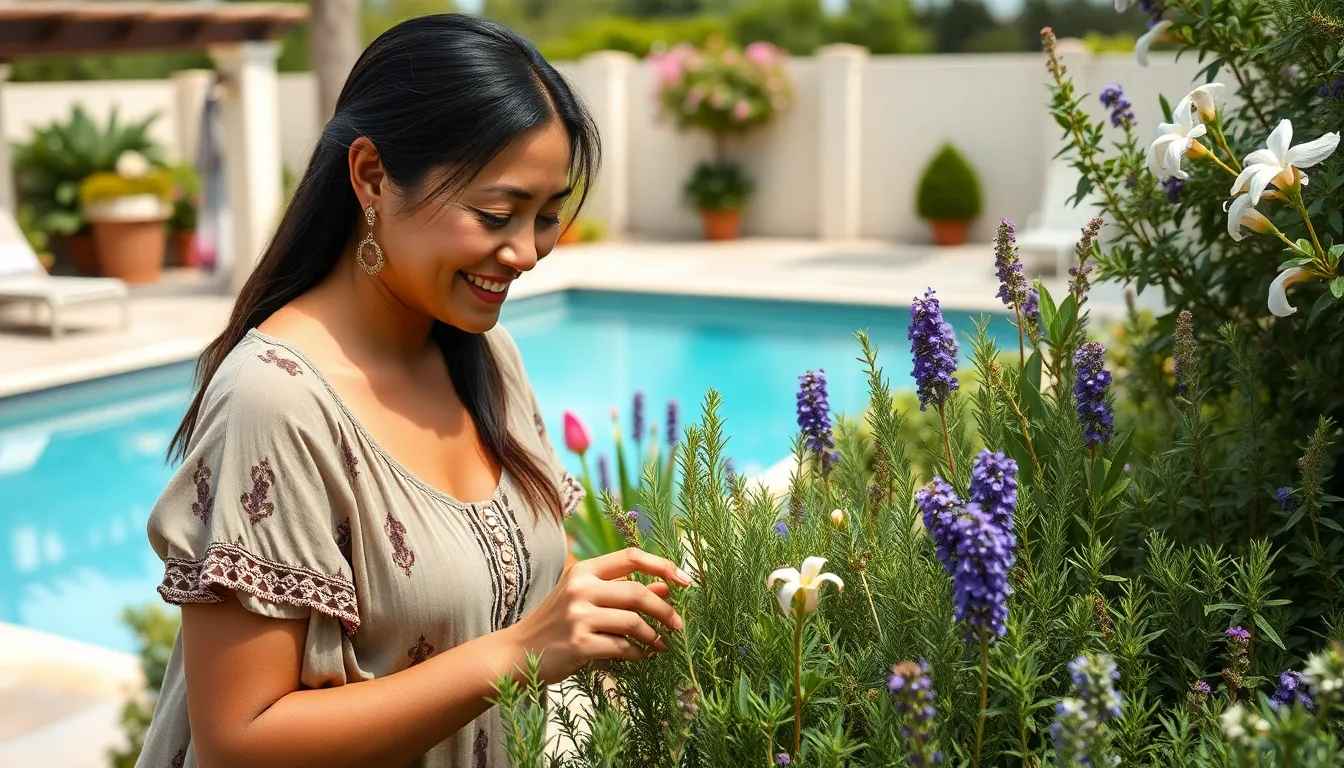
Adding aromatic plants around your pool transforms the space into a sensory retreat that engages both sight and smell. We’ve carefully selected fragrant varieties that thrive in poolside conditions while creating an inviting atmosphere for relaxation and entertainment.
Aromatic Evening Bloomers
Evening bloomers release their strongest fragrances after sunset, making them perfect for nighttime pool gatherings. Jasmine produces sweet, star-shaped flowers that emit an intoxicating scent during evening hours, creating a romantic poolside ambiance without overwhelming daytime activities. The fragrance intensifies as temperatures cool, providing a natural aromatherapy experience for late-night swims.
Gardenia offers another exceptional evening blooming option with its creamy-white flowers that release rich, heady fragrances in warm, humid climates. These elegant shrubs thrive in the moisture-rich environment around pools, producing their most potent scents during cooler evening temperatures. We recommend positioning gardenias near seating areas where guests can fully appreciate their luxurious fragrance.
Sweet-Scented Climbing Vines
Climbing vines maximize fragrance without consuming valuable ground space around your pool deck. Arabian jasmine provides subtle yet delightful fragrance that can be trained on pergolas or trellises near the pool area, adding vertical beauty while maintaining an unobtrusive scent profile. This versatile vine creates natural privacy screens while contributing gentle aromatic notes to the poolside atmosphere.
Training these fragrant climbers on overhead structures allows the scent to drift naturally over seating and swimming areas. The vertical growing habit makes them ideal for small pool spaces where ground area is limited but you still want aromatic benefits. We find that positioning climbing vines on the prevailing wind side helps distribute their pleasant fragrances throughout the entire pool area.
Herb Gardens Near Pool Areas
Poolside herb gardens combine practical functionality with aromatic appeal, offering fresh ingredients for poolside dining alongside pleasant scents. Rosemary serves as an excellent poolside planting choice, providing earthy, fragrant aromas while offering culinary uses for outdoor cooking and entertaining. This hardy herb tolerates pool chemicals and salt spray while maintaining its distinctive pine-like fragrance year-round.
Creating dedicated herb sections near your pool integrates sensory pleasure with practical benefits for outdoor lifestyle. Lavender emits calming scents that enhance relaxation while adding vivid purple hues to the industry design. We suggest placing herb gardens within easy reach of outdoor kitchens or grilling areas, allowing you to harvest fresh ingredients while enjoying their natural fragrances during pool activities.
Privacy Plants for Secluded Pool Spaces
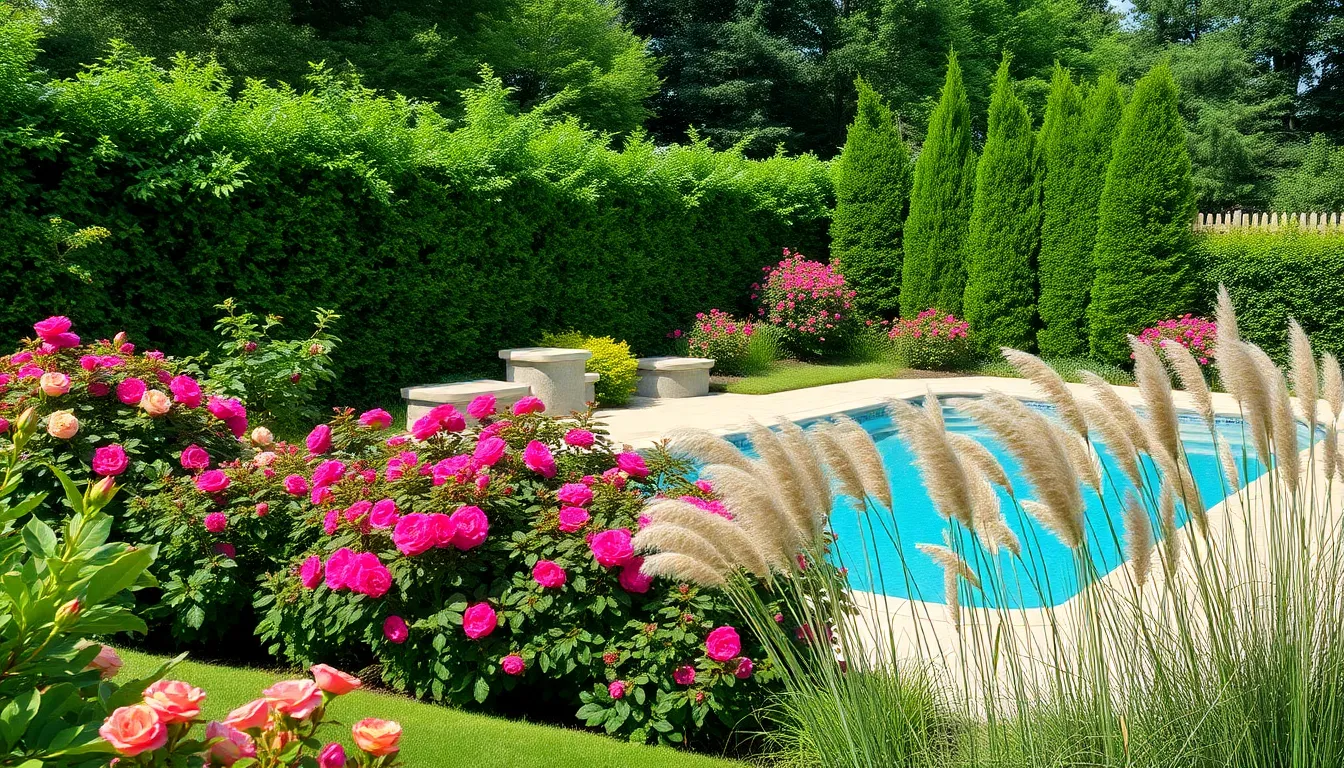
Creating a private sanctuary around your pool requires strategic plant selection that balances functionality with aesthetic appeal. We’ll explore proven options that establish effective screening while maintaining the luxurious atmosphere you’ve been building.
Fast-Growing Hedge Plants
Rose bushes deliver dual benefits of vibrant blooms and natural security barriers for pool privacy. Shrub, wild, and rugosa varieties thrive in sunny poolside conditions while producing thorny branches that deter unwanted intrusion. We recommend planting these roses in clusters to create dense coverage that complements your existing aromatic herb gardens.
Holly bushes form exceptionally thick privacy hedges with their spiny leaves and year-round evergreen growth. These hardy shrubs maintain consistent screening through all seasons, providing reliable privacy that pairs well with your existing non-invasive plant selections. Their dense foliage creates effective visual barriers without the root spread concerns you’ve been avoiding.
Barberry bushes offer colorful ornamental value alongside their privacy screening capabilities. These thorny shrubs develop dense branching patterns that enhance security while adding seasonal color variations to your poolside industry. We’ve found they work particularly well when combined with container plantings for flexible design options.
Firethorn shrubs withstand both heat and cold while producing bright red fruits that add visual interest to privacy screens. Their spiky foliage creates natural barriers that complement the safety features you’ve incorporated around your pool area. These heat-tolerant plants require minimal maintenance once established, fitting perfectly with your low-maintenance approach.
Tall Ornamental Grasses
Tall ornamental grasses provide semi-transparent privacy screens that add movement and texture to your poolside environment. These fast-growing plants create swaying visual barriers that soften pool edges while maintaining the tropical atmosphere you’ve cultivated. We recommend selecting varieties that complement your existing fountain grass and pampas grass installations.
Sun-loving grass species thrive in well-drained poolside sites, offering privacy without the dense coverage of traditional hedges. Their height creates effective screening above eye level while allowing filtered light to reach lower plantings. These grasses integrate seamlessly with your salt-resistant plant selections, tolerating occasional chlorine exposure.
Texture variations in ornamental grasses add dimensional interest to privacy screens around pool areas. We suggest combining different grass heights and colors to create layered privacy that enhances rather than blocks your carefully planned tropical aesthetic. Their seasonal changes provide year-round visual appeal that complements your fragrant evening bloomers.
Screening Trees and Bamboo
Norway Spruce trees create year-round privacy with dense branching that extends to ground level. These evergreens grow up to 100 feet tall and wide, maintaining low branches essential for effective pool screening. Their adaptability to various soil and light conditions makes them reliable choices for establishing permanent privacy around your pool area.
Arborvitaes form natural fence-like screens when planted closely together, creating continuous privacy barriers. These coniferous trees require proper spacing for optimal growth while providing the dense coverage needed for secluded pool spaces. We recommend these for their compatibility with your existing evergreen shrub selections like boxwood and juniper.
False Cypress varieties offer easy maintenance screening in multiple shapes and sizes for customized privacy answers. These adaptable trees provide dense foliage year-round while remaining manageable in size compared to larger screening options. Their versatility allows integration with your established tropical plant themes.
Bamboo species deliver fast-growing, tall screens that create tropical aesthetics around pool areas. Clumping bamboo varieties provide dense privacy coverage without the invasive spreading concerns that could affect your pool equipment. We suggest selecting these for their rapid growth and compatibility with your existing Bird of Paradise and palm plantings.
Seasonal Plants for Year-Round Pool Appeal
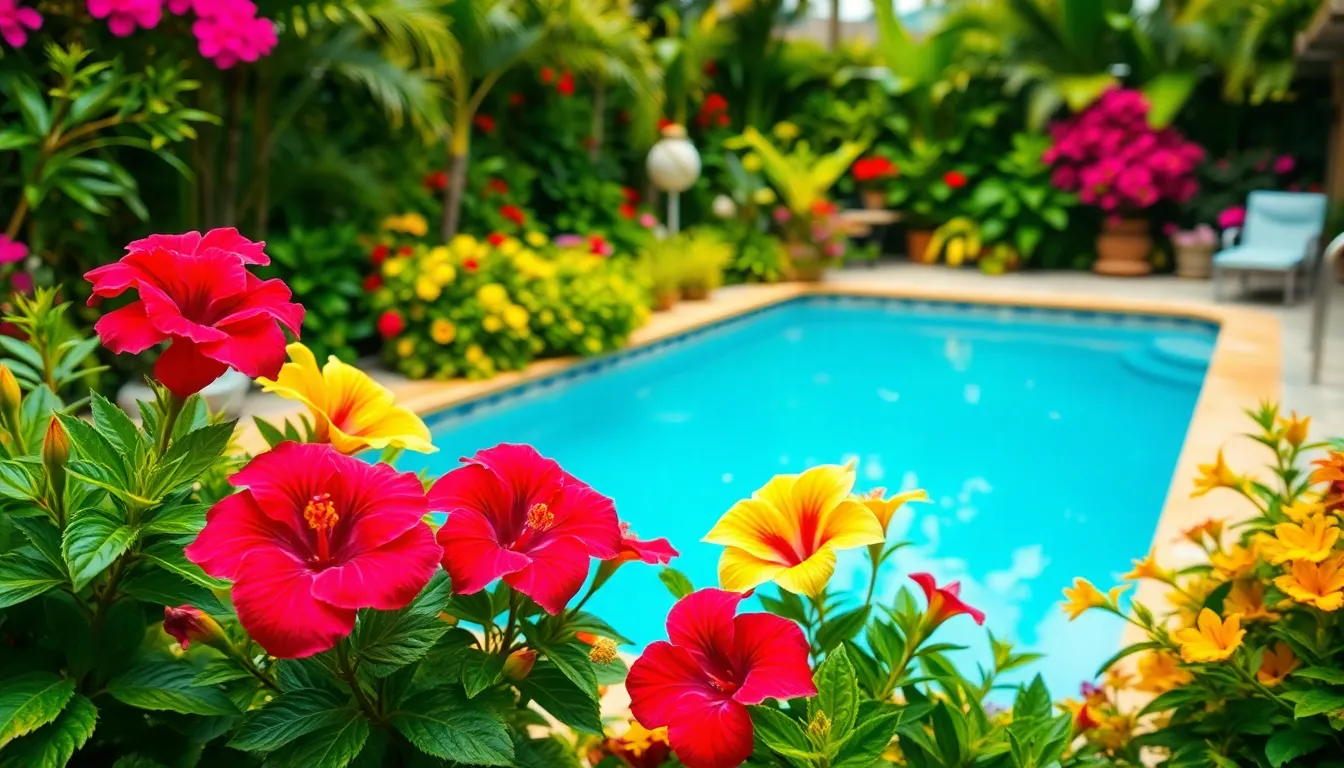
Creating a stunning poolside industry doesn’t have to sacrifice beauty for any particular season. We’ll explore plants that ensure your pool area maintains visual appeal throughout the entire year.
Spring Blooming Pool Plants
Lantana offers vibrant tropical colors while thriving in full sun conditions around pools. This drought tolerant plant provides bold blooms that emerge in spring and continue throughout the growing season. Oleander creates stunning displays with its colorful flowers and leathery leaves that resist pool chemicals and salt spray.
Bougainvillea transforms pool areas into Mediterranean paradises with its papery bracts in shades of pink, purple, and orange. These vigorous climbers handle intense sun and require minimal water once established. Bird of Paradise adds exotic appeal with its orange and blue flowers that emerge in late spring and early summer.
Azaleas now bloom multiple times throughout the year thanks to new varieties that resist pests and diseases. These compact shrubs tolerate full sun better than traditional varieties and provide colorful displays in spring. Coral Bells ‘Georgia Peach’ creates striking borders with its vibrant peach and rose purple foliage plus delicate white flowers in late spring.
Summer Heat-Resistant Varieties
Hibiscus shrubs deliver continuous blooms all summer long with their large, showy flowers in tropical colors. These heat loving plants enhance the resort style atmosphere while requiring minimal care beyond regular watering. Sedum ‘Pool Party’ thrives in mineral rich, well drained soil and full sun conditions that often challenge other plants.
Geraniums withstand pool splashes and drought conditions while producing cheerful flowers throughout summer. Regular deadheading keeps these versatile plants blooming vibrantly in containers or garden beds. Palms create natural shade and privacy screens while handling intense summer heat with minimal maintenance requirements.
Cannas provide bold tropical foliage and bright flowers that love summer heat and humidity. Crotons add colorful leaf patterns in shades of yellow, red, and green that intensify in hot weather. Ginger plants offer fragrant blooms and lush foliage, while Elephant Ears create dramatic focal points with their oversized leaves.
Fall and Winter Interest Plants
Coral Bells ‘Georgia Peach’ deepens to rose purple in fall and winter, providing year round visual interest beyond its spring blooms. This compact perennial maintains its colorful foliage even in cooler temperatures. Certain azalea varieties continue blooming into fall, extending the flowering season well past traditional spring displays.
Evergreen shrubs maintain structure around pools when deciduous plants lose their leaves in winter. These reliable plants require minimal maintenance while providing consistent greenery and form. Palms offer tropical appeal throughout winter in warmer climates and can be moved indoors in containers where temperatures drop.
Multi season azaleas provide color even as temperatures cool, with some varieties producing flowers in both spring and fall. These versatile shrubs adapt to changing seasons while maintaining their pest and disease resistance. Structural evergreens like juniper and boxwood keep the poolside looking polished during dormant seasons.
Conclusion
Creating the perfect poolside paradise requires careful plant selection that balances beauty with functionality. We’ve shown you how to choose species that thrive in challenging pool environments while improving your outdoor living space.
From drought-tolerant succulents to fragrant evening bloomers our curated plant recommendations ensure you’ll enjoy a stunning industry year-round. These carefully selected varieties offer privacy screening natural fragrance and visual appeal without creating maintenance headaches.
Remember that successful poolside landscaping isn’t just about aesthetics—it’s about creating a safe functional space that complements your pool rather than competing with it. With the right plant choices you’ll transform your pool area into a resort-style retreat that enhances every swimming season.
Frequently Asked Questions
What makes a plant suitable for poolside planting?
Poolside plants should be heat-tolerant, chemical-resistant, and low-maintenance. They need to withstand salt spray, chlorine exposure, and intense sunlight without requiring excessive care. The best choices are drought-tolerant species that won’t drop debris into the pool and can handle the challenging microclimate around swimming areas.
Which low-maintenance plants work best around pools?
Drought-tolerant succulents like agave, aloe vera, and echeveria are excellent choices requiring minimal watering. Hardy perennial grasses such as fountain grass and pampas grass provide movement and privacy. Evergreen shrubs like boxwood, rosemary, and juniper offer year-round structure and resilience to pool chemicals.
What tropical plants create a resort-style pool atmosphere?
Palm species are ideal for creating natural privacy screens and shade while requiring minimal maintenance. Colorful flowering hibiscus adds vibrant blooms, and Bird of Paradise provides dramatic visual impact. These plants thrive in USDA zones 9-11 and tolerate poolside conditions while creating a luxurious tropical ambiance.
How do I choose plants that can handle chlorinated pool water?
Select salt-resistant plants that naturally thrive in coastal conditions. Mediterranean herbs like rosemary and lavender tolerate salt while providing fragrance. Coastal natives such as sea lavender and beach sunflower handle salt spray well. Ornamental grasses like pink muhly grass and ground covers also excel in these conditions.
Which plants won’t damage pool equipment with their roots?
Choose shallow-rooted ornamental plants like coral bells and lavender that won’t threaten underground systems. Compact flowering bushes such as roses and holly provide privacy with controlled growth. Container-friendly options like succulents and tropical palms eliminate root spread concerns while allowing flexible design placement.
What ground cover plants reduce slip hazards around pools?
Low-growing alternatives like creeping thyme and sedum provide traction and visual appeal. Irish moss and Blue Star Creeper excel in poolside conditions while reducing slip risks. Combining fibrous plants like dwarf mondo grass with materials such as decomposed granite enhances both traction and drainage.
Which fragrant plants enhance the poolside experience?
Evening bloomers like jasmine and gardenia release fragrances at night, creating romantic ambiance. Sweet-scented climbing vines such as Arabian jasmine maximize fragrance without taking ground space. Herb gardens featuring rosemary and lavender provide both aromatic appeal and practical culinary uses near the pool area.
How can I create privacy around my pool with plants?
Fast-growing hedge plants like rose bushes, holly bushes, and barberry provide security and beauty. Tall ornamental grasses create semi-transparent privacy screens with natural movement. Screening trees and bamboo offer effective barriers while maintaining a tropical atmosphere and blocking unwanted views.
What plants provide year-round visual appeal around pools?
Spring bloomers like Lantana, Oleander, and Bougainvillea provide vibrant colors in full sun. Summer heat-resistant varieties such as Hibiscus, Cannas, and Crotons withstand high temperatures. For fall and winter interest, evergreen shrubs and multi-season azaleas maintain structure and color throughout cooler months.

